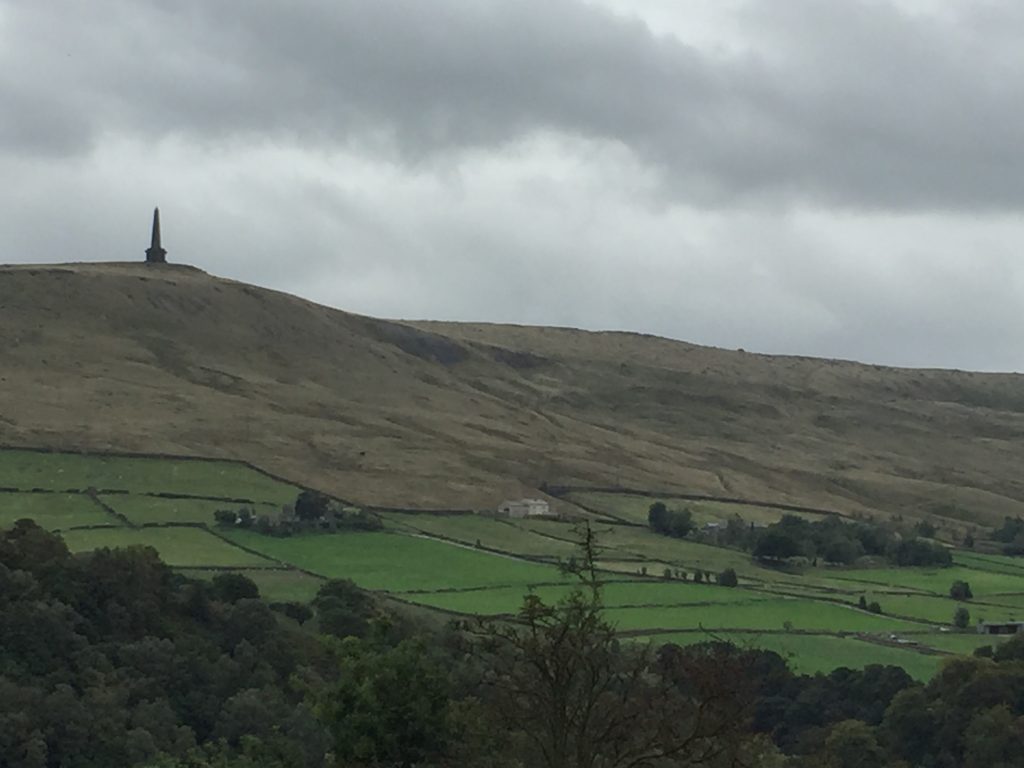
CHARLES CRABTREE – manufacturer – and his son, Walter of Stansfield Hall
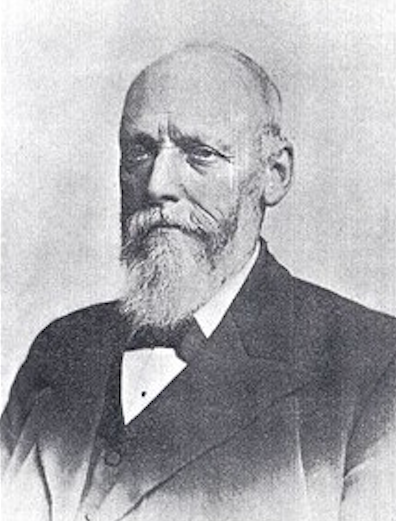
There are certain family names in the Calder Valley that are so ubiquitous that people researching their family history pray that they won’t find them in their family tree. Greenwood is one. Sutcliffe is another. A third is Crabtree, so it was with some trepidation that I embarked upon digging into the roots of Walter Crabtree. Walter’s parents, Charles and Ellen, are a perfect example of the confusion such names can cause the genealogist. They were married on April 6th, 1865. Ellen’s maiden name was Crabtree. She married Charles Crabtree. Both their fathers were named Abraham Crabtree! Charles’s father was a greengrocer. Ellen’s father was a farmer. And to further confuse matters on June 16th 1867 an Abraham Crabtree of Chapel House, a grocer and farmer drowned in a dam at Cockpit, Todmorden. (annals of Tod) p24. This didn’t bode well, but I knew that a certain Charles Crabtree, who was a distant relative of mine was a man who had made his mark in Todmorden, both as a mill owner and a benefactor, so perhaps I would be able to distinguish this particular Charles from all the other Crabtrees in the vicinity. He is connected to my family through Edith Wrigley who married his son, Walter Crabtree in 1906.

Charles’s obituary dated 1912 reads “Beginning life in a humble way, with no apparent advantages over his fellows, he rose by industry and enterprise to a position of a large employer of labour.” Charles was born in 1832 at Upper Eastwood, a small cluster of houses centred around Eastwood old hall that I’d explored last year. Apart from the group of buildings around Eastwood Old Hall with its datestone that reads John Eastwood, 1630, the hillside leading up to Great Rock is criss- crossed with paths and dry stone walls amongst which are scattered isolated homesteads with only rough cart tracks leading to them even today. Sitting high on the hillside with uninterrupted views across the Calder Valley to Stoodley Pike is one of these isolated dwellings, Greystone, where Charles aged 9 was living with his parents, Abraham, a worsted weaver and his mother Ann in 1841. From Greystone a track leads through two fields to two adjoining cottages named Chapel Houses.

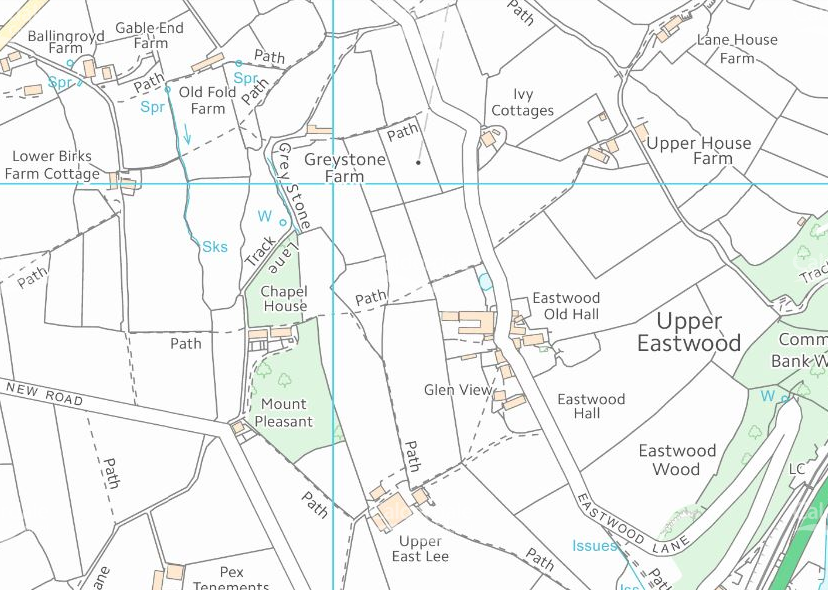
As its name suggests this building was originally a chapel, Benthead Chapel constructed in 1719 and capable of holding 200-300 people. I still find it mind blowing that on such a remote hillside a chapel capable of holding so many people was required.
According to the Charlestown history page “ From the mid 18th century, the chapel went into decline due to the ‘exceptional mortality in the district’. Hmmm. I wonder what caused this ‘exceptional mortality” in this area. Could it possibly have been caused by inbreeding? On one page in the 1851 census 14 out of 19 people listed are Crabtrees. The congregation dropped to a handful of people” and the building was subsequently divided into cottages. On the 1851 map the lane connecting these three locations, Eastwood, Greystones and Chapelhouses, all closely associated with my Crabtree ancestors was marked Crabtree Lane! A description of the place on the Charlestown history site which the site states was probably written in the 1840s reads:
“It must not be imagined from what has been written so far, that the inhabitants of Eastwood were all upright and honest citizens. There were evil doers in those days as there are now, and laws against theft or damage to property were much more drastic. Tradition has it that representatives of the village were sent as convicts to Australia. Stealing was by no means uncommon and occasionally cloth was taken from the handlooms. Hand weaving persisted for a long time after the coming of the power loom, and the weavers sometimes took precautions against theft by tying the warp ends to their feet before retiring for the night……The less reputable amongst the population indulged in such sports as cock fighting, rabbit coursing, clog fights or wrestling for wagers. The Non Conformists on the other hand, still strongly under the influence of puritan tradition, looked askance at such pleasures and regarded them as enticements of the Devil”.
It was the beginning of March, 2021. We’d had a few consecutive days of Spring weather – meaning it hadn’t poured with rain and the temperature had stayed above 32F, so I set out find Greystones where Charles, a boy of 9 was living with his father Abraham, a worsted weaver and mother Ann in 1841. As I took the bus up to Blackshawhead the sun won the battle with the clouds and by the time I got off at the bus terminus 1000ft above sea level it was a lovely sunny Sunday morning. Opposite the bus terminus is the former Blue Ball pub where Ezra Butterworth had rather too much to drink one night and staggered home down Davey Lane to his home at Hippens, where he went to bed, fell out again in a drunken stupor breaking the chamber pot and dying from his wounds. His story is told on another page of this blog. I followed Davey Lane with its wonderful views across the Calder Valley across to Stoodley Pike, passed the scene of Ezra’s demise. Today I noticed an ancient paved trail leading West from Hippens bridge alongside Hippens Clough which looked interesting to explore some other time.
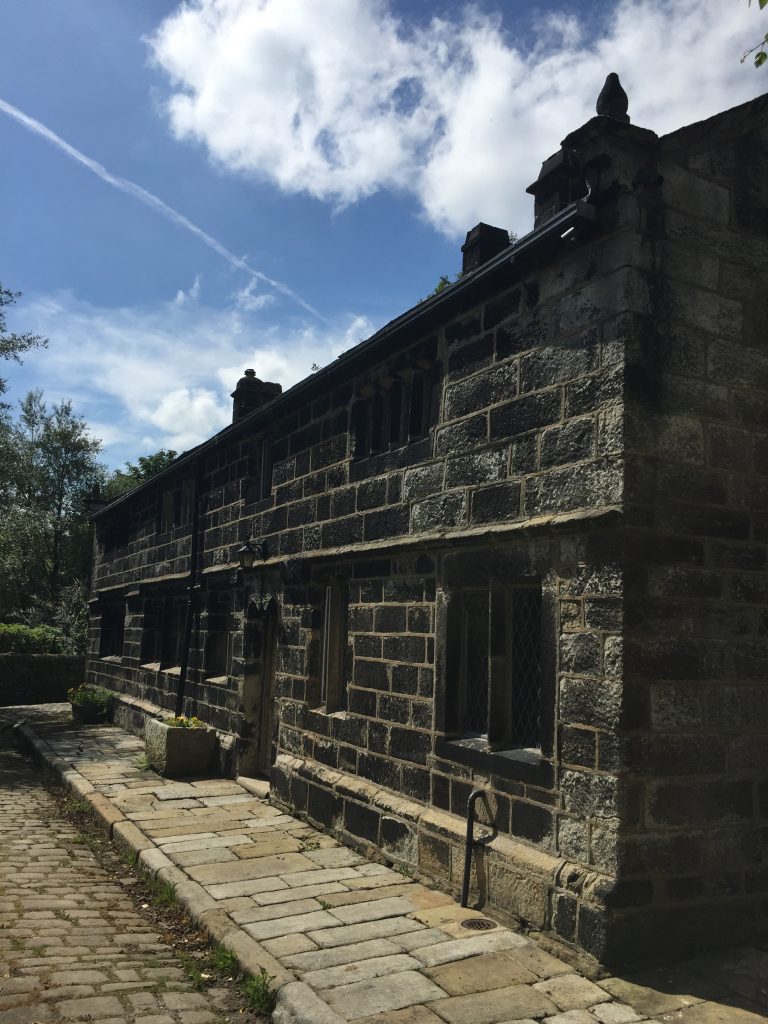
Hippens. 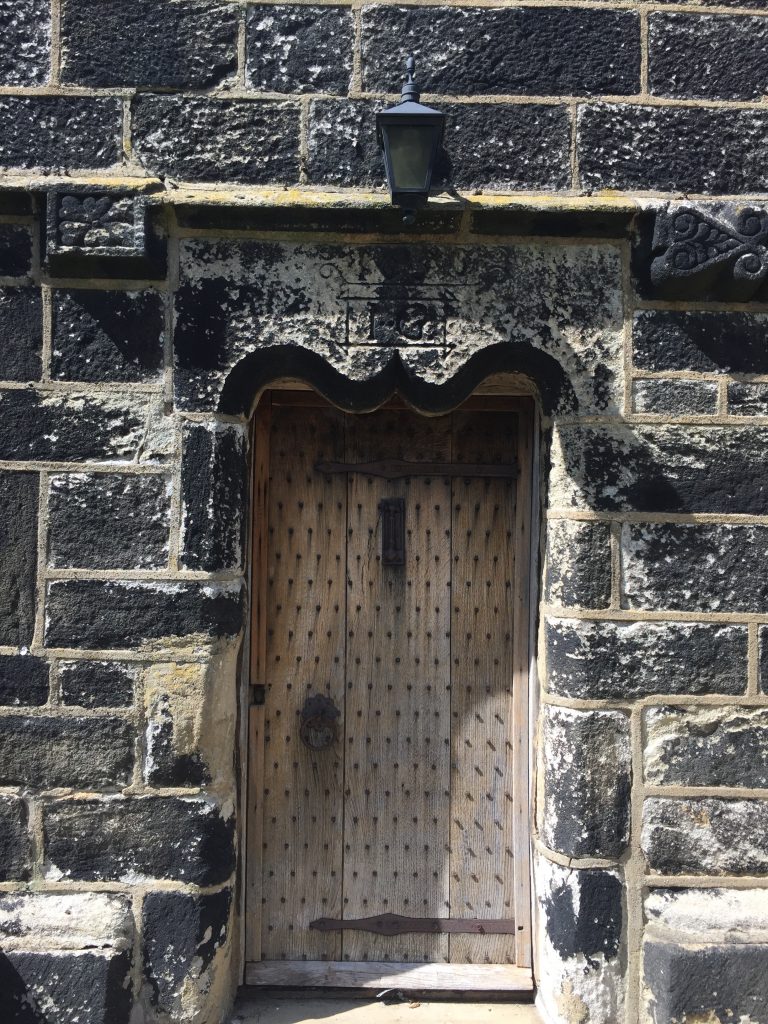
Home of Ezra Butteworth
I reached Great Rock which I’d noticed is marked as Grisly Stone on the 1851 map. Sometimes it’s been known as Devil’s Rock. It’s an outcrop of millstone grit that’s been weathered into a fantastical shape, similar to Bridestones which is close by. I even found my maiden name etched into it along with dozens of others.
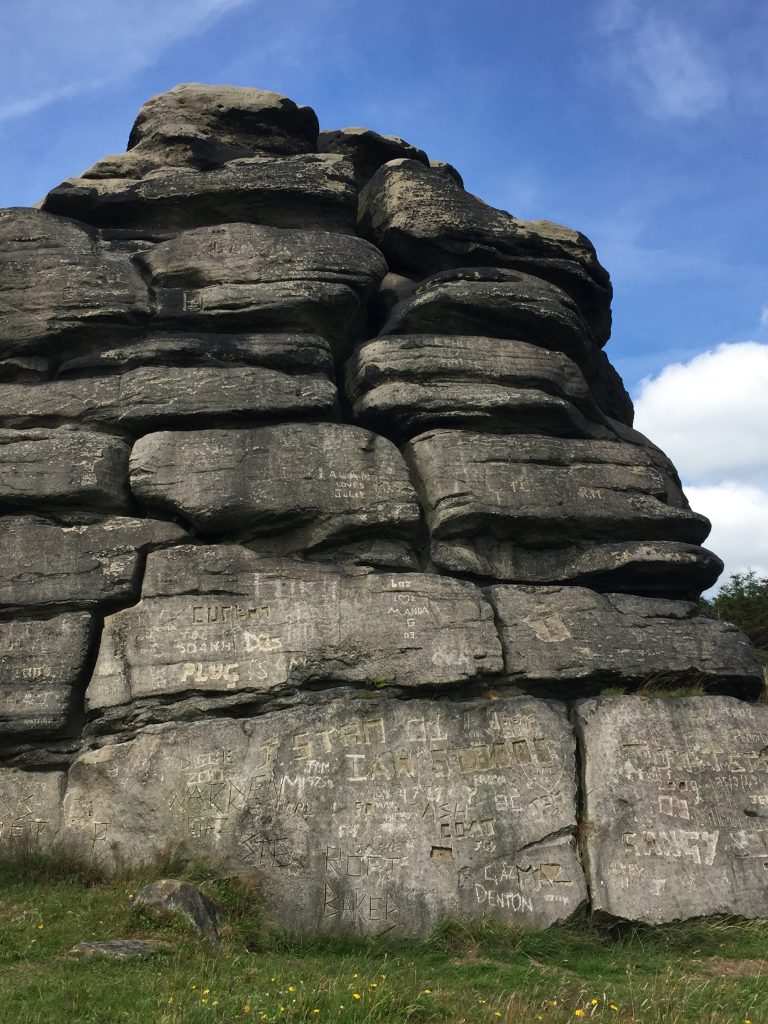

At Great Rock I took a pathway of Eastwood Lane. It’s surface reminded me of a patchwork quilt of stones and bricks obviously constructed, reconstructed and patched over many many years, centuries.
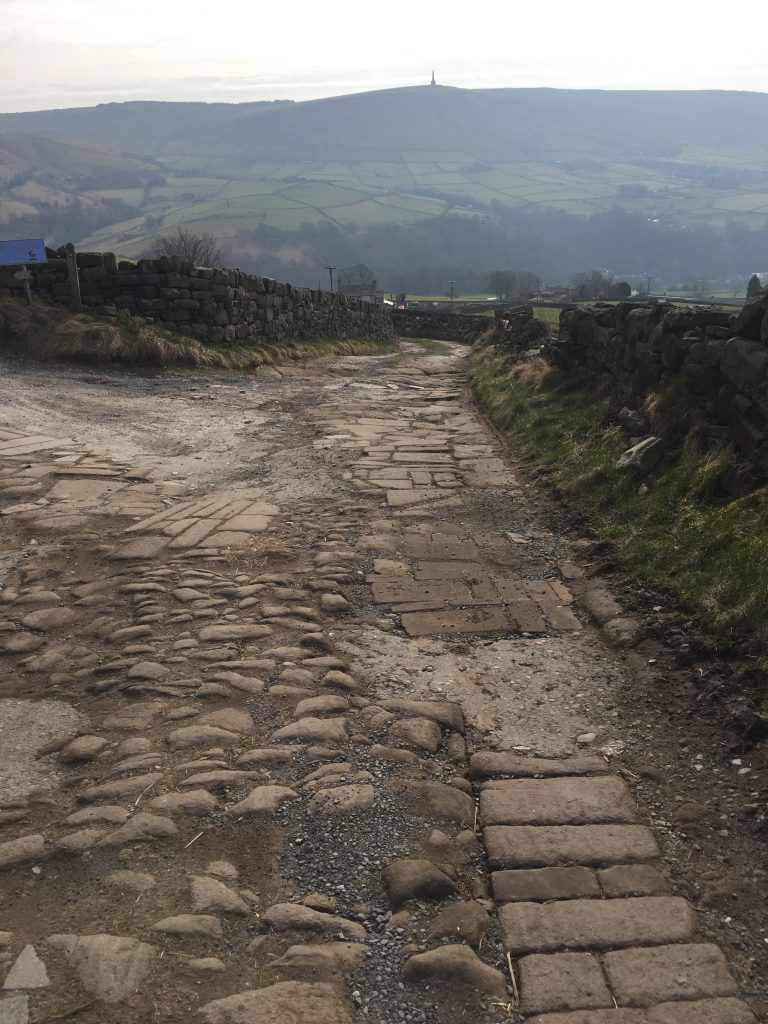
To my right a smaller track was signposted to Greystone Farm (only) and I could see a long stone building across the field. I headed for the farm which faces Stoodley Pike and though I stopped to take photographs for several minutes no-one came out to talk to me. I was disappointed.
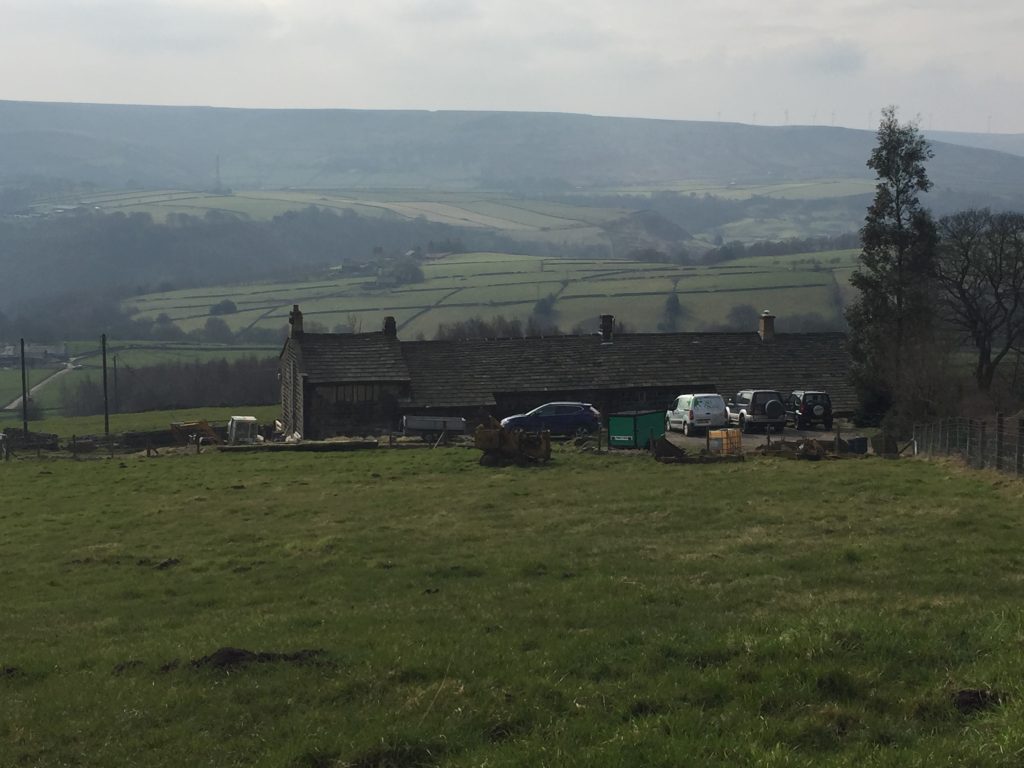
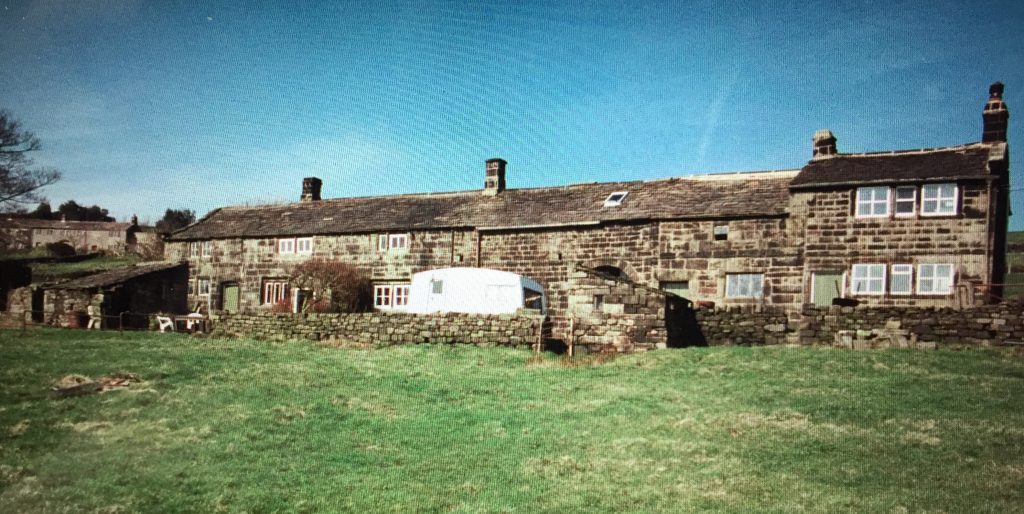
According to Historic England the earliest deed of the property is 1675 and the single storey gabled porch bears date 1789. The farmhouse is to the left, then comes the barn which still has its semi circular cart entry and then on the far right the cottage has a higher roof line. On an 1851 map I’d traced a track to the side of Greystones which led to Chapelhouses, but I’d not bargained for such difficult walking conditions. The path was sunken between two walls and was really no more than a stream. That would have been OK if the stream had had stones at its bottom. My boots are waterproof. The problem was mud! Mud in which my boots almost disappeared, so deep was it. It was very sticky too, and trying to lift up my foot out of its clutching grasp was no easy thing. I found myself clutching at various branches and grasses to steady my slips but all that resulted in was getting hands full of blackberry thorns. Luckily this track only lasted for 15 minutes. I wondered if was an ancient holloway like Bow Lane which connected Hudson Mill Road to Blackshawhead where the amount of that path has sunk is commensurate with its age.
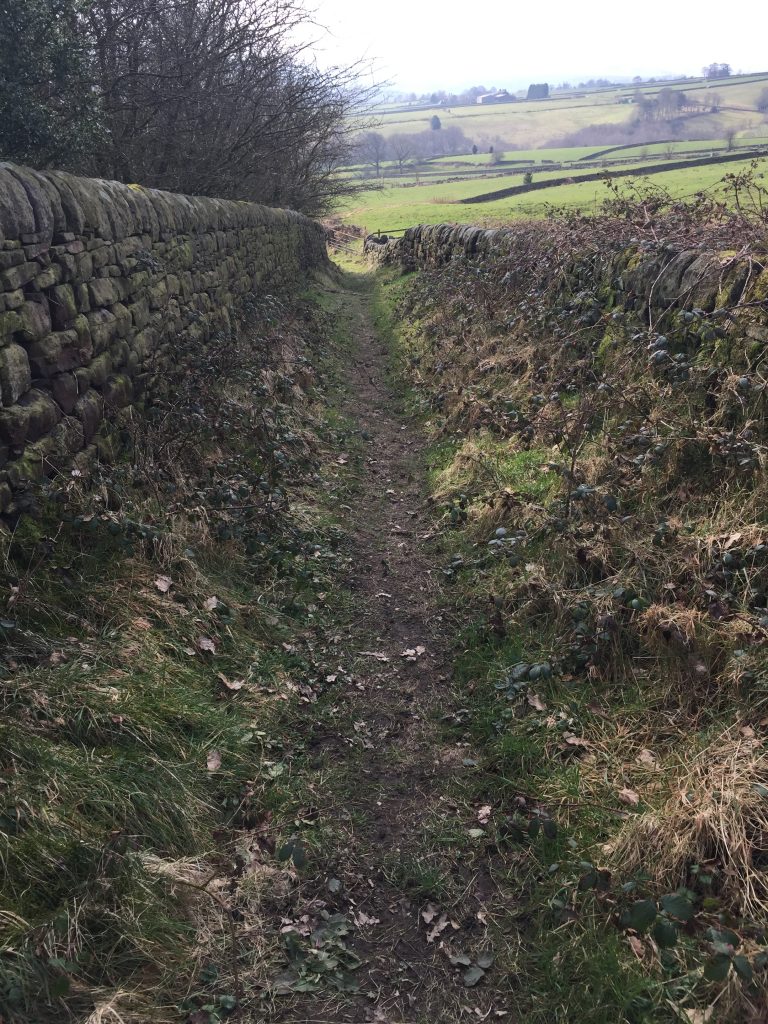
From this… 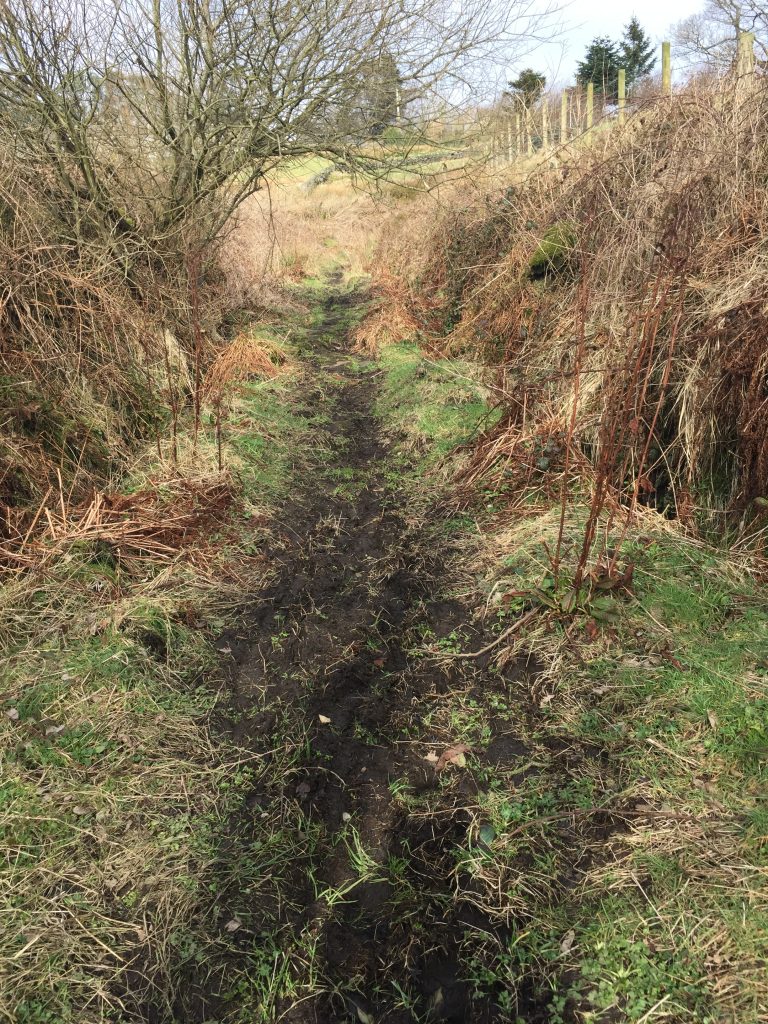
… to this…. 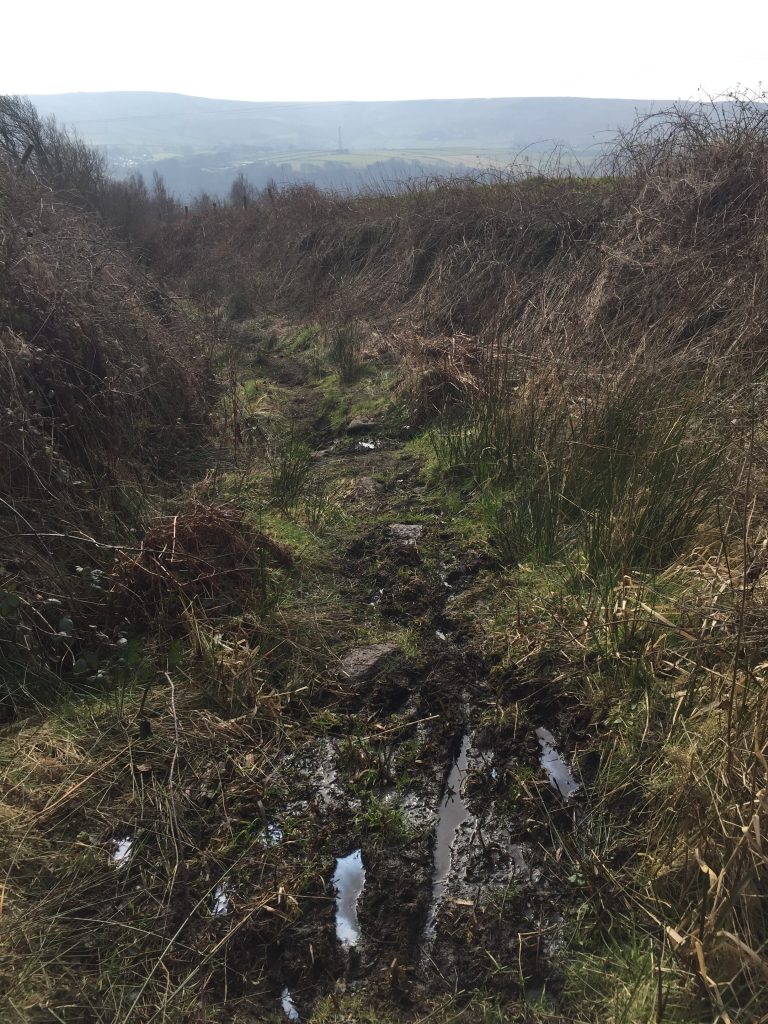
… to this
I found myself in a more open area and adjacent to the gable end of a building. If I was correct this should be Chapelhouses, originally Benthead chapel. My luck was in. A couple were enjoying the sunshine in their garden and I explained my presence. There are two buildings now, one Chapelhouses and next door Chapelhouse Farm. Both buildings are Grade ll listed and it was the building on the left that was one Charles’s home. According to Historic England it was built in the late 17th or early 18th century and was used for non-conformist worship in the mid 18th century and was converted into four cottages in the mid 19th century.
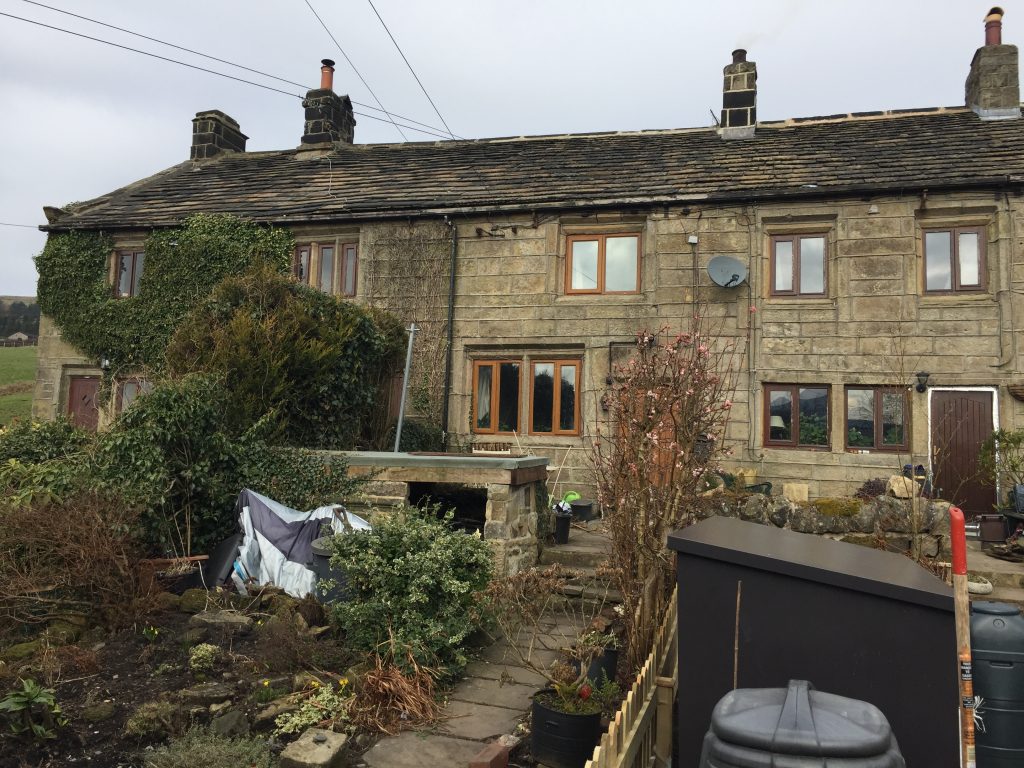
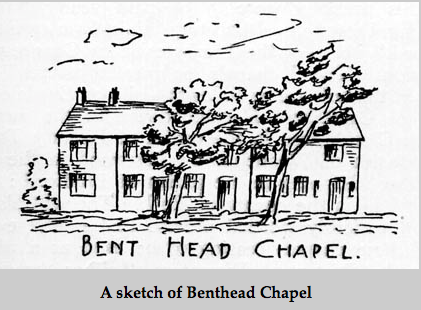
They were interested in my Crabtree story and soon went to find the person next door who lives in the part of the building that was actually the chapel. I learned that around 1900 the building had been left empty and it wasn’t until the 1980’s that it was restored and made into four dwellings. (Just like Lily Hall). I was able to take photos of the building and just make out the datestone by the door though it’s impossible to decipher. Apparently these is an old photo before the renovation but I haven’t been able to find in online. There is no mains water still here, and water is obtained from a nearby spring.
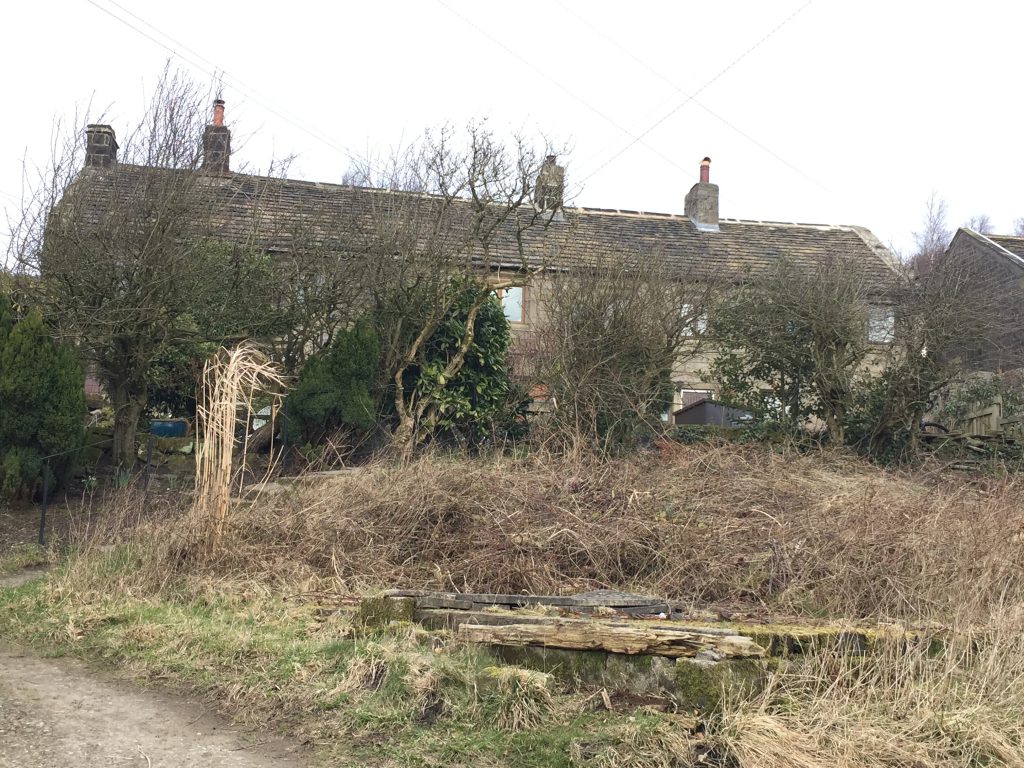
By 1851 Charles was listed as a cotton weaver living with his parents in Eastwood, though in this census the names of many of the houses are not specified. But six homes away in the old Bentwood Chapel which was being shared by 6 families was another Abraham Crabtree, a grocer, with his wife Mary and three daughters, Mary Ann, 20, a cotton weaver, Ellen, 18, a dressmaker and Betty, 16. Also living with them was Young Barker a grandchild, aged 10. Being ten years old Young Barker is obviously not the illegitimate son of one of Abraham’s daughters which is usually the case. (see wikitree). It was almost a case of marrying the girl next door because two days before Christmas in 1852 Charles and his betrothed Mary Ann Crabtree made what must have been a cold journey into Halifax to be married at St John the Baptist church. They were one of seven couples who were married there that day. After their marriage they set up home in one of the sections of Chapel houses – now the home of five different Crabtree households! The first ten years of their married life saw the birth of a son, Barker, and a daughter Ann, named after her grandmother. But not only that, Charles had become a cotton manufacturer, employing seven men, a major step up from the weaver he was on his marriage certificate. Everything seemed to be going well for the young family but then Mary died. She was just 33. The couple had had two children and I wondered if she died in childbirth. Just over a year later he married Ellen Crabtree at St John’s in Halifax, the same church as his first wedding. Not only that but and together they had five children. Charles, Mary Ann and Ellen all had fathers named Abraham Crabtree! This is why I was reluctant to begin any research into my Crabtree ancestors! It took me a while to figure out that Ellen was none other than Mary Ann’s younger sister. I think that the writer of the register was as confused as I was, because in the margin he has added Chapelhouses, which convinces me that I have the correct people! Together Ellen and Charles had five children. Perhaps my suggestion of inbreeding possibly causing the usually high incidence of mortality in this vicinity was not too far from the truth.
Charles’s family demonstrates succinctly the development of the textile trade in the Calder Valley. His father, Abraham, had been a handloom weaver living at Greystones high on the hill above Eastwood but by the time Charles was 18 his family had moved down the hill into the small community of Eastwood and both father and son were employed in cotton manufacturing. In fact a cotton manufacturer, Thomas L. Sutcliffe was their immediate neighbour in Eastwood and it’s likely that it was in Sutcliffe’s cotton spinning mill in Eastwood that the father and son earned their living. Eastwood Shed was built between 1833 and 1848 for cotton weaving. The addition of this weaving shed to the spinning at Upper Mill created an integrated cotton manufacturing unit. An earlier small water powered cotton spinning mill in Higher Eastwood. The mill had been built by the Eastwood family and then leased to a number of manufacturers over the years, one such being the Sutcliffe Brothers.
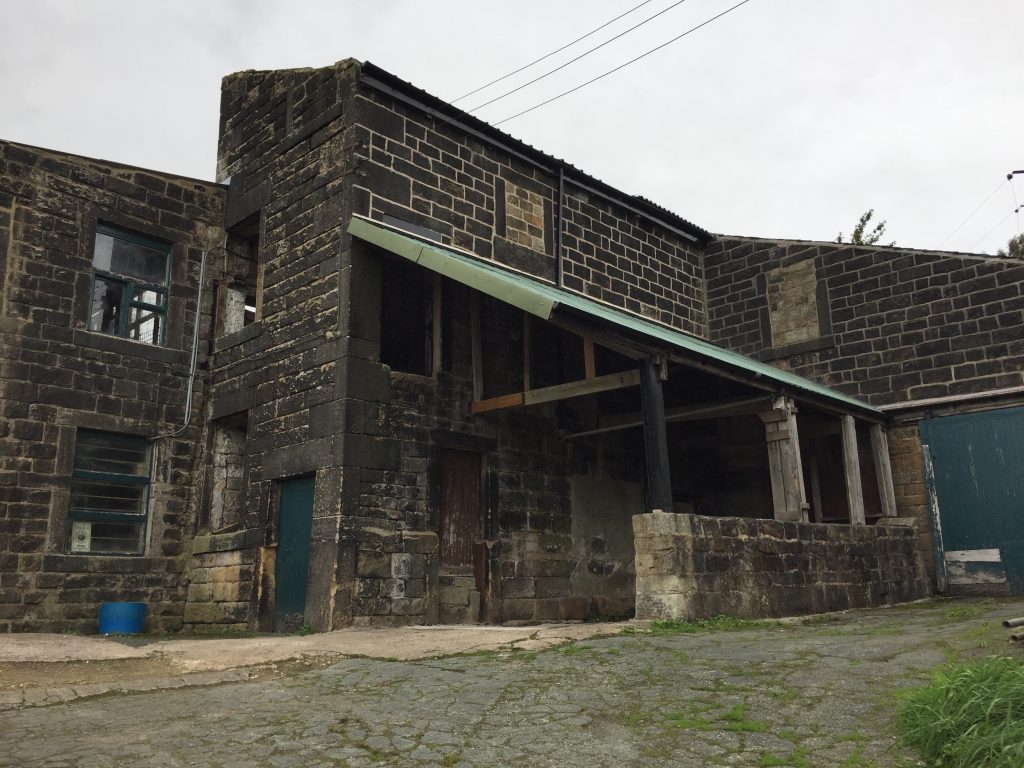
Eastwood shed where Charles and his father were employed in the cotton mill 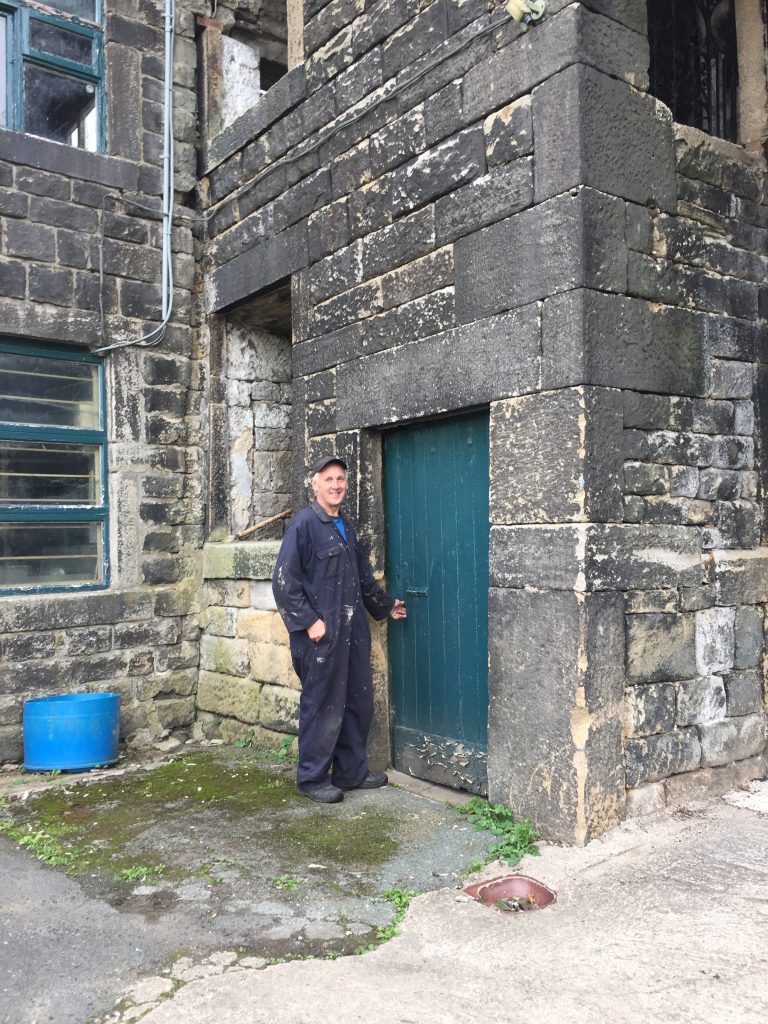
My visit to Eastwood in Sept 2018 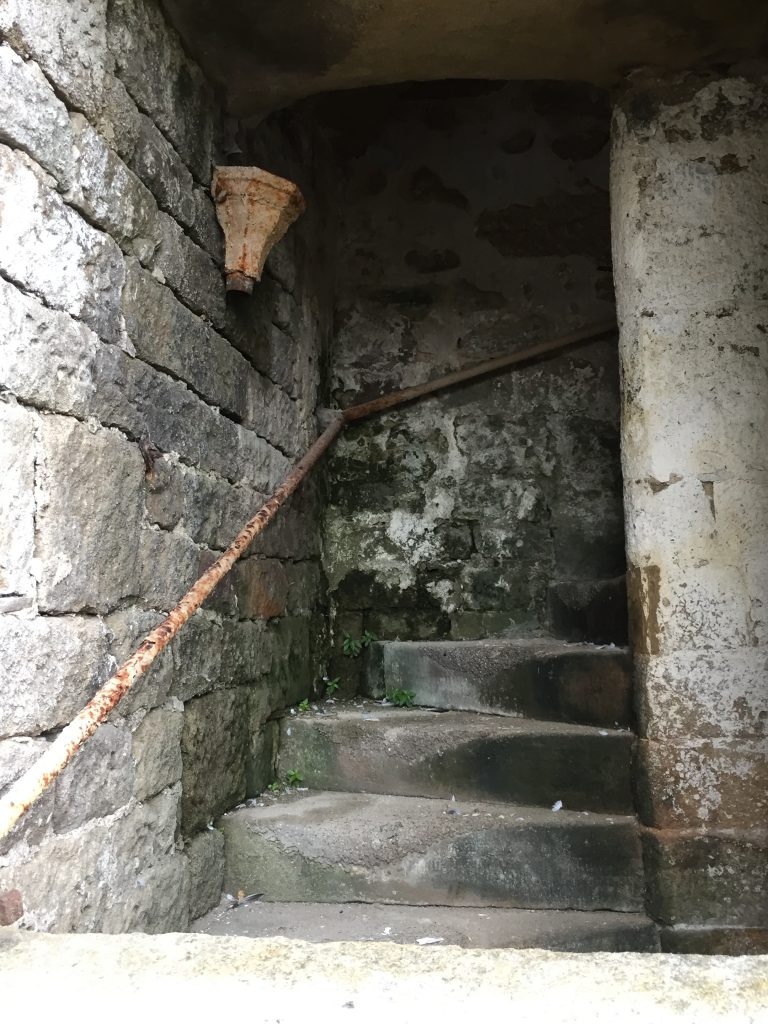
Spooky steps to the tower that housed the waterwheel
Two years ago I’d taken a hike up the steep road to Eastwood and seen all that remains of the mill today. A friendly resident of Rose cottage was, of course, pruning his roses and offered to show me round. The three storey mill shed, which once housed the waterwheel is now used as a cow shed. I peeked in to see the heavily worn stone steps of a spiral staircase, its rusted handrail, the peeling whitewashed walls – all very spooky. The man led me above the mill site to view the original mill ponds now the site of some lovely gardens. This was later replaced by a horizontal Lancashire steam boiler which was dragged up the hillside from the bottom by 12 chained horses. Though Edward Cartwright had invented the weaving machine in 1784 several decades of refinement were necessary and it wasn’t until 1842 that the semi-automatic Lancashire Loom came into being taking weaving from a home-based artisan activity to a steam driven factories process.
In December 1860 Charles Crabtree launched out as an employer running a business with John Marshall, operating a few looms at Burnt Acres on the valley floor employing 7 people. So the employment – just like the chapel, has moved from the hillside in Eastwood to the valley bottom, giving access to the canal for both the shipment in of raw materials and the shipment out of finished goods, as well as the river to power looms before the advent of steam power. This mill was to be my first stop on my ‘Crabtree day.’
The site of Charles Crabtree’s mill was easy to locate being sandwiched on a narrow strip of land between the Calder River and the Rochdale Canal in Eastwood but the mill that occupies the site now is not the original Crabtree mill. Charles gradually increased his business and he moved with Ellen into the centre of Todmorden. Unfortunately their home on Dale Street hasn’t survived. In 1884 he acquired Ferney Mill with 614 looms.
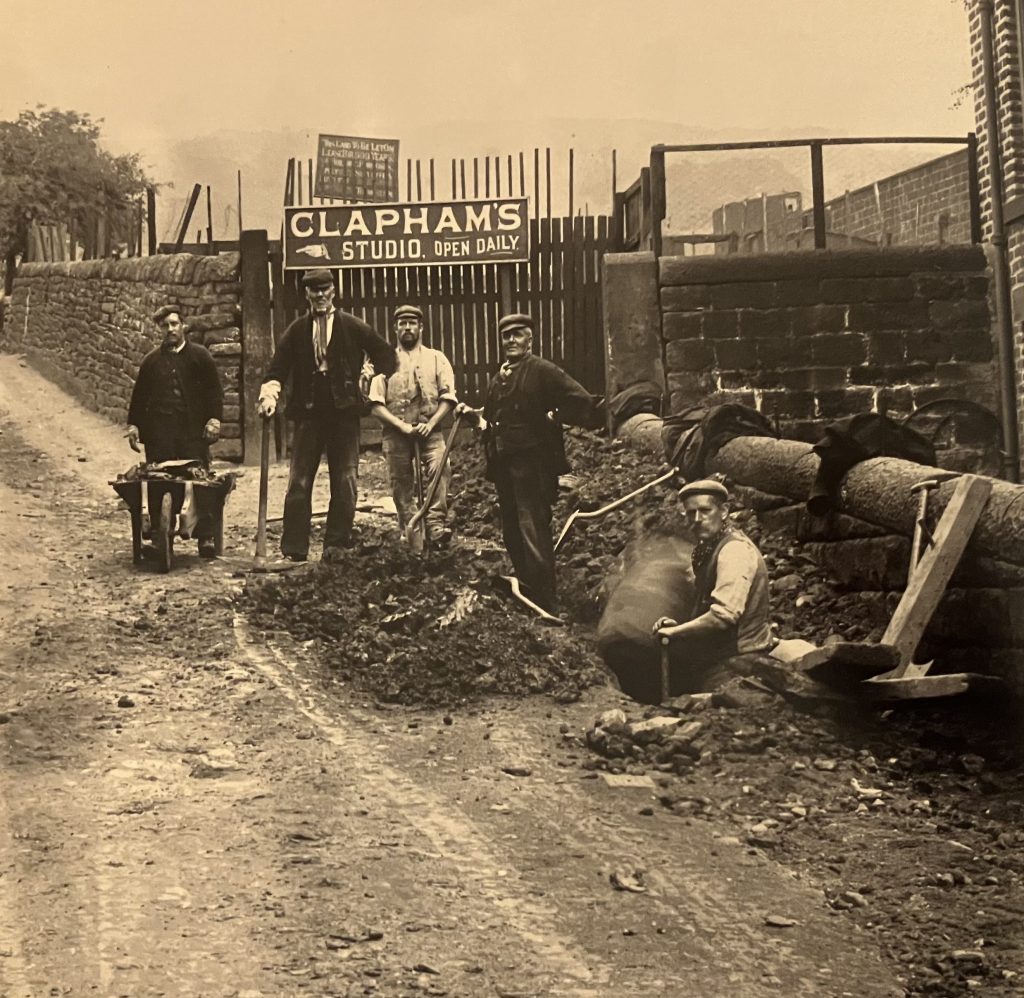
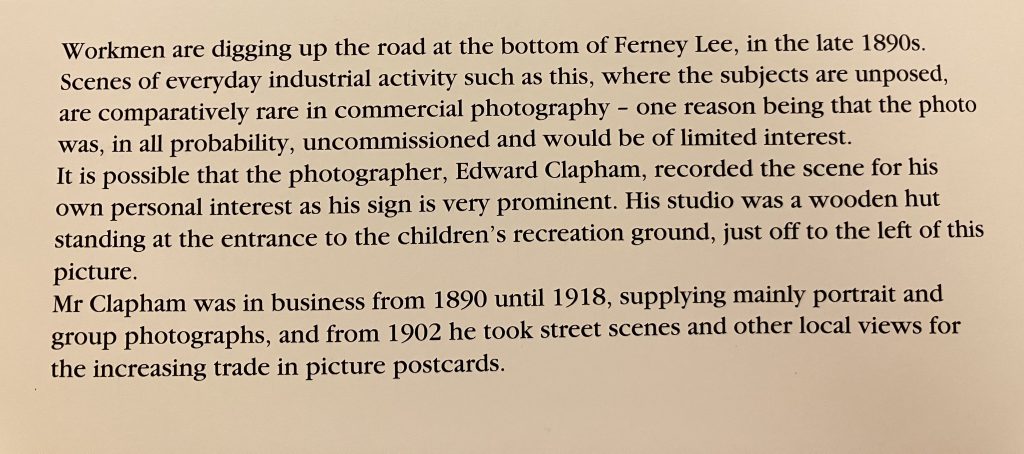
I continued along the canal towpath, reminding myself of its important role in Charles’s business, and once in Todmorden I took the road out towards Burnley. Only a mile from the town centre I located Ferney Mill Road but the mill itself is no longer there.
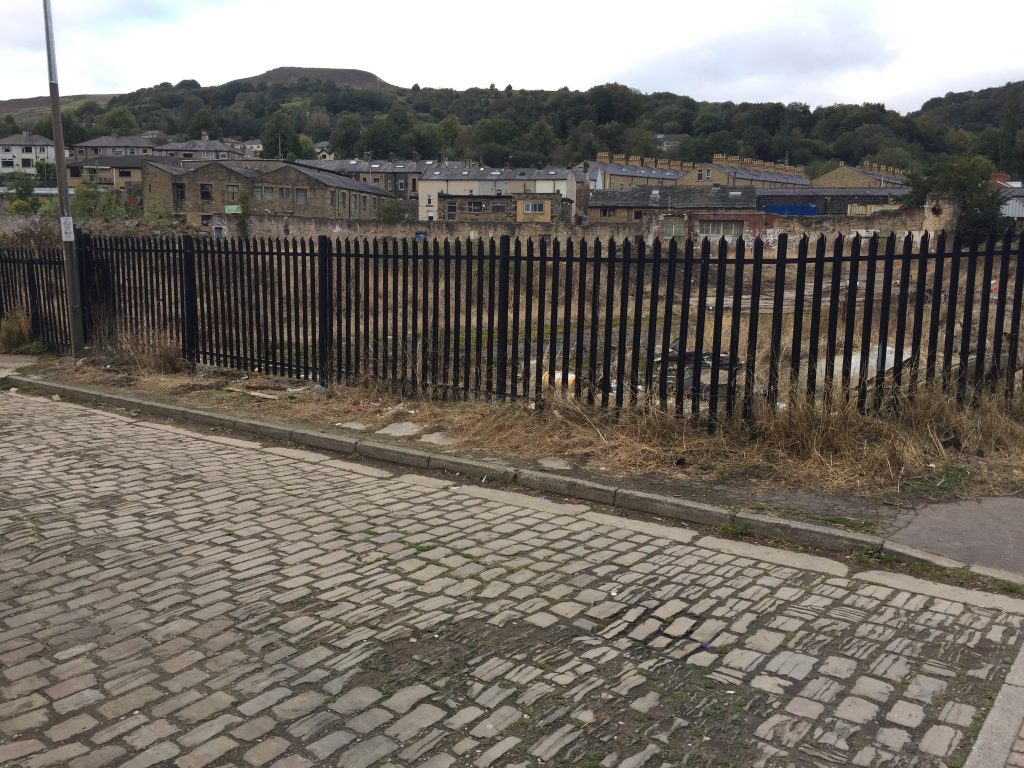
Site of Ferney Mill 
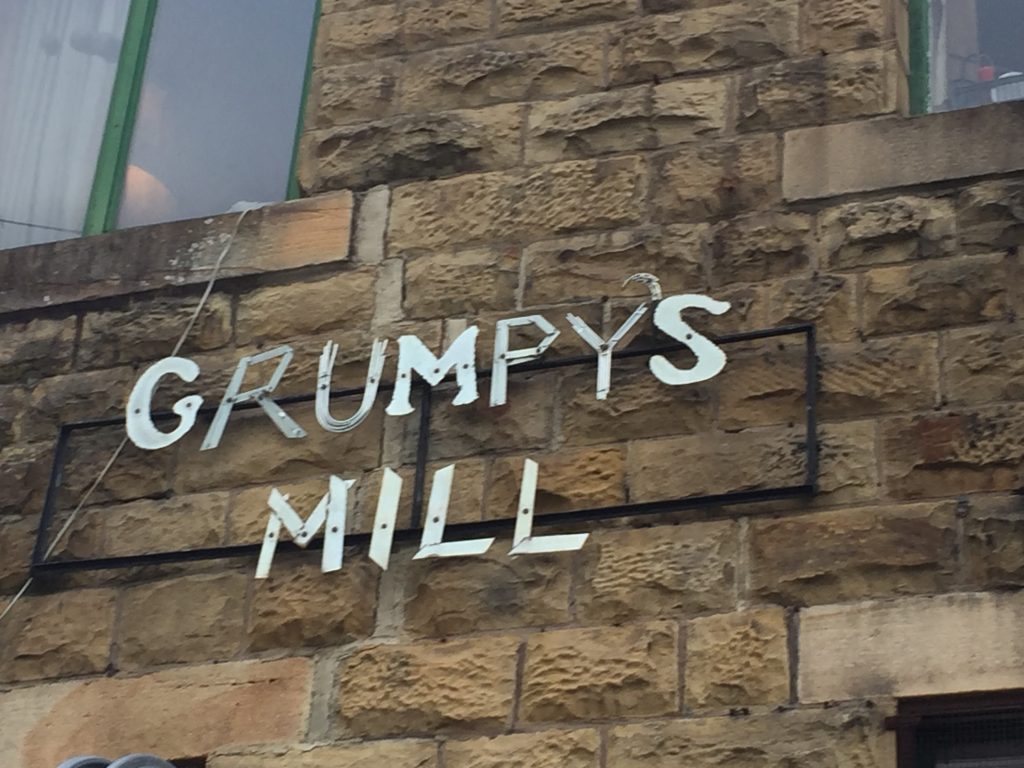
I put a posting on Todmorden Past and Present Facebook page and received the following response from Rebecca Marshall: “My father bought the mill and demolished it and built the houses there now. However I did find a career poster dated around 1950 to attract workers. At that time about 400 operatives were working at Ferney Mill: “Good wages, good conditions and good employee services are proffered for employees while engaged in the manufacture of Florentine and Satin Drills and ring Weft yarns specially spun for the local drill trade. There is a weaving school and a training school covering the spinning processes, a research and welfare department, cricket and sports clubs and social committee. As an added incentive Tea and sandwich service is available for the morning and afternoon rest breaks!” I wandered around this area in Todmorden where vast areas of wasteland surrounded by ruined walls topped with razor wire are all that remain of the huge textile mills that once covered this valley. Today many are used as dumping grounds and one had an amazing array of unwanted children’s furniture and toys including a large pink and white unicorn. Farther along Ferney Lee Road a former mill building had been converted into a suite of studios and workshops and the name Grumpy’s Mill was emblazoned in fancy ironwork. Was this part of Charles’s mill I wondered? When I got home I ran this question on the Todmorden Past and Present Facebook page and within a few hours I got the following response; I wasn’t aware of ‘lee’ being in the name but certainly Ferney Mill. Its mine!” And from a lady “I worked at Crabtree Mill when I left school.”
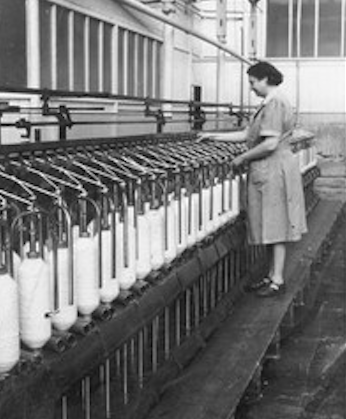
Charles appears to have been well liked by his employees and when he died in 1912 his obituary read: Last year, on the attainment of his jubilee as a manufacturer, Mr. Crabtree gave a treat to his employees, and they in return made a presentation to him of a walking stick, and of an umbrella to Mrs. Crabtree. For a long number of years, Mr. Crabtree attended Heptonstall Parish Church and officiated as sidesman for Stansfield. He was also identified with St. Paul’s Church, Cross Stone, and he had close ties with Myrtle Grove Congregational Church, Eastwood where he had been baptised. I was keen to visit the chapel but like so many others in this ‘Valley of a Hundred Chapels’ (the title of Amy Binns’s book) so many of them have been demolished or are used for secular purposes. The only thing remaining of the chapel is its graveyard. From the Charlestown history site: By the early 1800s, with the coming of industrialisation, the population was moving from the tops into the valley bottom. Discussions about moving the chapel began in about 1805 and local gentry settled endowments for the new chapel to be built. The new chapel opened in the summer of 1807 was called Myrtle Grove and stood on the site that later became Eastwood Railway station. It had a capacity of 500 people. The congregation again declined from about 1820. In 1838 the railway petitioned to include the site of the Chapel and it was purchased by the railway company in the following year. Another of my ancestors, Thomas Butterworth and his wife Alice (nee Jackson) had their 6 children baptised together at Myrtle Grove chapel just two years after Charles.


The model of Myrtle Grove chapel
Though not able to view the actual chapel itself I was able to get a good three dimensional view of the 1840 chapel from a very unexpected source which rather amused me. Again, from the Charlestown history site: A few years ago one of the group was taking stuff to the tip at Eastwood and saw a small wooden model in a skip. She rescued it and later we discovered that it was of Eastwood Chapel. Who made it, when or why, we don’t know. It’s a three storey stone building. .
After Charles’s second marriage in 1865 he and Ellen went on to have five more children, the youngest being Walter who was born in 1875. Cross Street where Walter was raised was in the centre of Todmorden but is now partly a car park and partly a garden area, from where I’ve watched the Lantern festival. It leads to the imposing Market Hall which was built in 1879. But I thought I’d pay a visit to where it once stood, to see if anything remained.
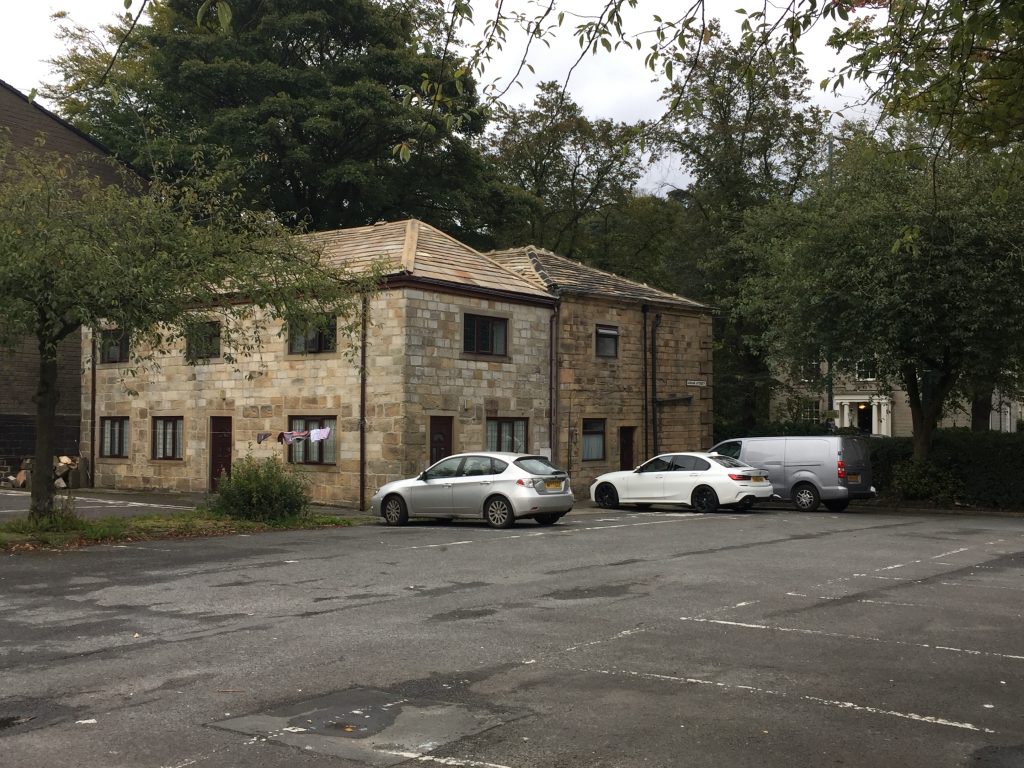
1 Cross street 
Home of Charles Crabtree
A double fronted house numbered 37 with a small iron railing around a flagged area barely two feet wide on the main Halifax Road seemed to be positioned close to where Cross Street once was, and, yes, lo and behold, on the side of the house high on the wall was an old street sign – Cross Street. A similar sized building had been added to the rear of the building and the side was adjacent to the car park. Could this possibly have been number 1, Cross Street, home of Charles Crabtree for at least the last 32 years of his life? When I got home I was eager to find if anyone could verify that number 37 Halifax Road was once 1 Cross Street, the home of the Crabtrees. I posted my question onto the Todmorden Past and Present FaceBook page and within 24 hours I’d had over 40 responses, two from former residents of the building. I learned that the house had once been called Galen House and after the Crabtrees left it had variously been the office for a local plumber, a toy shop, and the home of a family who operated a taxi business. One former resident, Sam Woodworth-Barnstone wrote “I always wanted to rip off the Cross Street sign when we left but always came round to the thought it’s been there over 100 years. Let’s see how many more years it can survive.” He then describes the inside of the house: “The best room was the attic. No-one ever looked up there but after everyone had moved out I had a peep. It extended the full size of the house with four original stone pillars in the middle with a skylight looking down on Halifax Road.” Charles and Ellen would remain living at Cross Street for the rest of his life, Charles dying in 1912 at the age of 80 and Ellen in 1919 at the grand old age for the time of 86. They are both buried at Cross Stone church high above Todmorden.
At the far end of Cross Street is the river with a footbridge. I crossed the bridge and found myself in a park with a children’s playground. It surely takes the Darwin award for the best park name: Tipside.
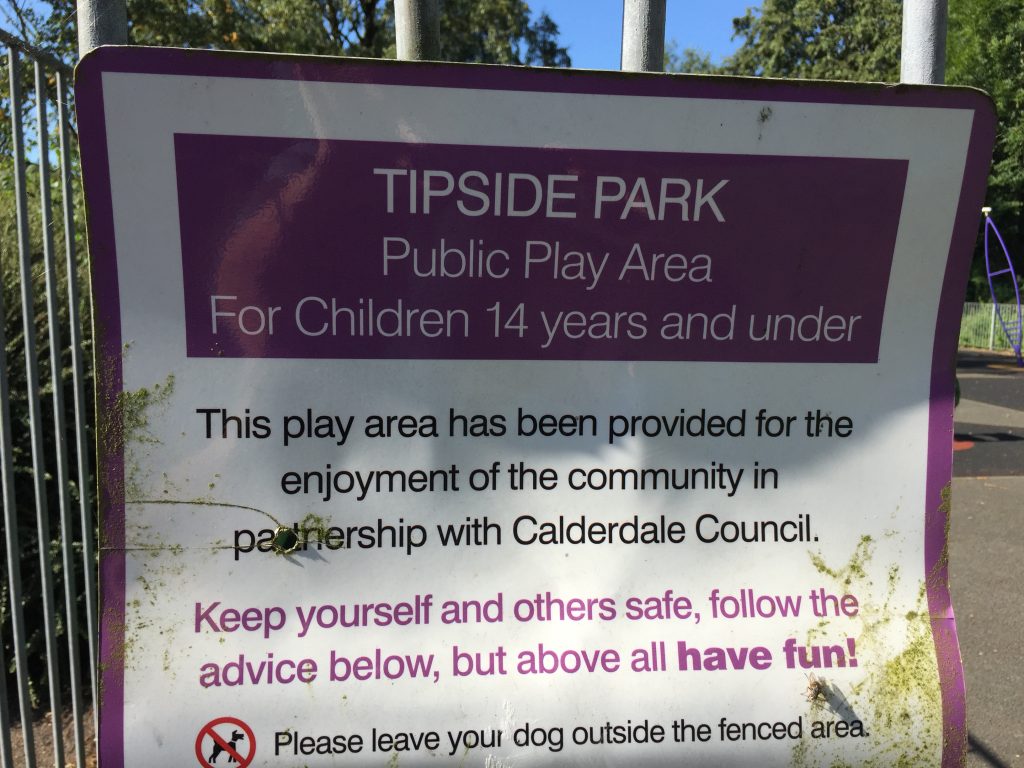
By 1891 two of the 5 Crabtree children were teachers, one was a warehouseman in a cotton factory – I wonder if it was his dad’s factory – and one was a dye machine maker – presumably an engineer. Walter was still a scholar at the age of 15, when most young men of his age at that date in time would have been earning a wage. In fact, on the same street in the 1891 census there is Willie Brocock, throstle spinner in a cotton factory, aged 11, Tom Halliday, a moving carrier aged 14, Emily Sparks, cotton spinner aged 12, and yes, another Crabtree family containing John, 13, a cotton weaver. I think it’s interesting that my Crabtree family is living cheek by jowl with their employees, rather than in a manufacturer’s mansion up a hill and away from the smoke and grime of the town. That this area of Todmorden, known as Roomfield, was not all sweetness and roses is born out by thus 1876 Nuisances inspector’s report. “In the first place I would remind you that Miss Sutcliffe, has a drain made up on her property in Roomfield Lane, and the house slops and refuse water are flowing on the street. At the same place, Stansfield Gibson, butcher, (another ancestor who I write about) has a very offensive midden on the side of the street leading up to the back houses, and be is also in the habit of slaughtering sheep and lambs in a place behind his house, which has not been registered as a slaughterhouse. Sarah Horsfall, of York street, has a privy on her premises with a defective box in, and the liquid runs on the door and out at the door bottom, and is very offensive.”
Walter enrolled at Owens College, Manchester, an institution that had been founded in 1851, named after a textile merchant, John Owens who had gifted almost 100,000 pounds for is establishment. Owens college eventually became the University of Manchester. What an amazing coincidence. My daughter, Anna, decided to study abroad for a year while she was pursuing a psychology degree at the University of California in Santa Cruz. The University she selected was Manchester and she was housed at Owens College, where I visited her in 2009. I love the following quotation from Wikipedia: Since the later 1800s many notable people have worked and studied at University of Manchester as, for example, Benedict Cumberbatch. Unlike Cumberbatch Walter studied not drama but medicine and in 1899 he received his MB ChB, a Bachelor of Medicine and Bachelor of Surgery. He became a house physician at Manchester Royal Infirmary and on October 30, 1906 he married into my family by taking as his bride Edith Wrigley, the daughter off Thomas Henry Wrigley, whose granddad had lived at Lily Hall in 1841 and whose great great granddad was none other than James Wrigley, my great great great great granddad.
A distressing account was to be found in the Todmorden newspaper on Dec 23, 1904 when Walter was at the home of his future wife as her mother was getting ready to go to chapel. At the inquest held at Todmorden Town Hall Edith related the story, “I was the sitting-room (upstairs) when I heard a bang. I went with Dr. Crabtree to see what was the matter, and we found my mother laid at the bottom of the attic stairs. She was lying face downward, with her feet on the bottom step. She was conscious, and said” I think I must have gone dizzy.” My father was not at home at the time. The stairs are not very steep. We lifted her on to the bed.” Walter takes up the story: I found she was paralyzed below the shoulders. I came to the conclusion that the spine was severely injured, probably with dislocation or treatise. Dr. Currie was, sent for, and with him I made an examination. I found the two lowest cervical vertebra and probably one or two of the dorsal vertebra displaced. Under such circumstances recovery was scarcely ever known. Death occurred rather suddenly at the last. The jury returned a verdict of ‘ Death from injury to the spinal cord, caused by accidentally falling downstairs.” The house where this happened was almost adjacent to the Town Hall, on part of Halifax Road that was known as York Street at the time of the accident. She was buried at Cross Lanes Chapel where, two years later Walter and Edith were married.
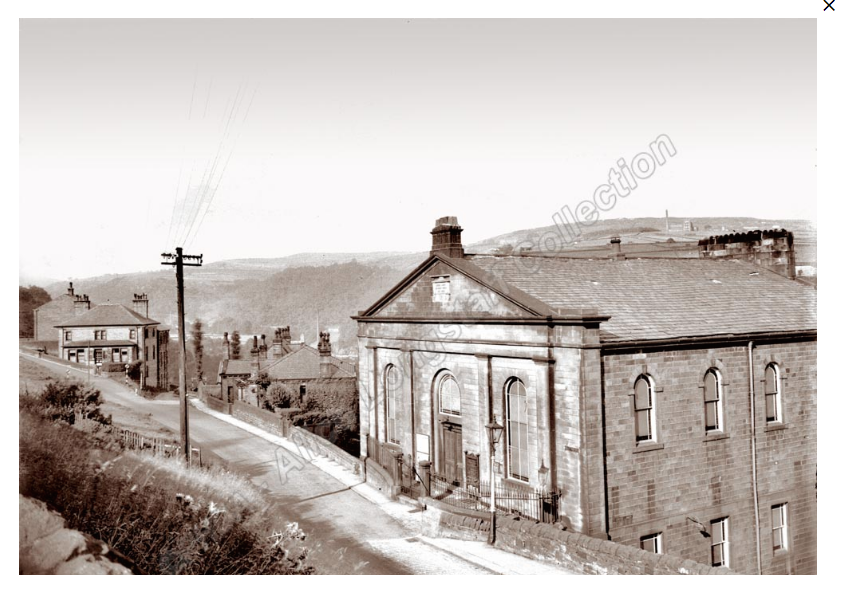
It’s one of the many churches which no longer exists, though the cemetery remains, barely clinging to the steep hill overlooking Hebden Bridge. The newspaper article seems to imply that there was an element of secrecy to it: An interesting wedding was solemnised on Tuesday afternoon at Cross Lanes chapel. It was kept as quiet as possible but many friends watched the ceremony . The contracting parties were Dr. Walter Crabtree, of Nelson, youngest son of Mr. Charles Crabtree. cotton manufacturer, Todmorden. and Miss Edith Wrigley eldest daughter of Mr. T. H. Wrigley (Messrs Wrigley and Sons, painters and paperhangers, Hebden Bridge and Todmorden). The bride, who was smartly attired in brown silk crepe de chine, with cream velvet hat, was attended by her sister (Miss Annie Wrigley). and was given away by her father. Mr. H. Cockcroft. of Woodlands. acted as best man. The newly-married couple afterwards left for London and Bournemouth to spend their honeymoon. They have received many handsome wedding gifts.
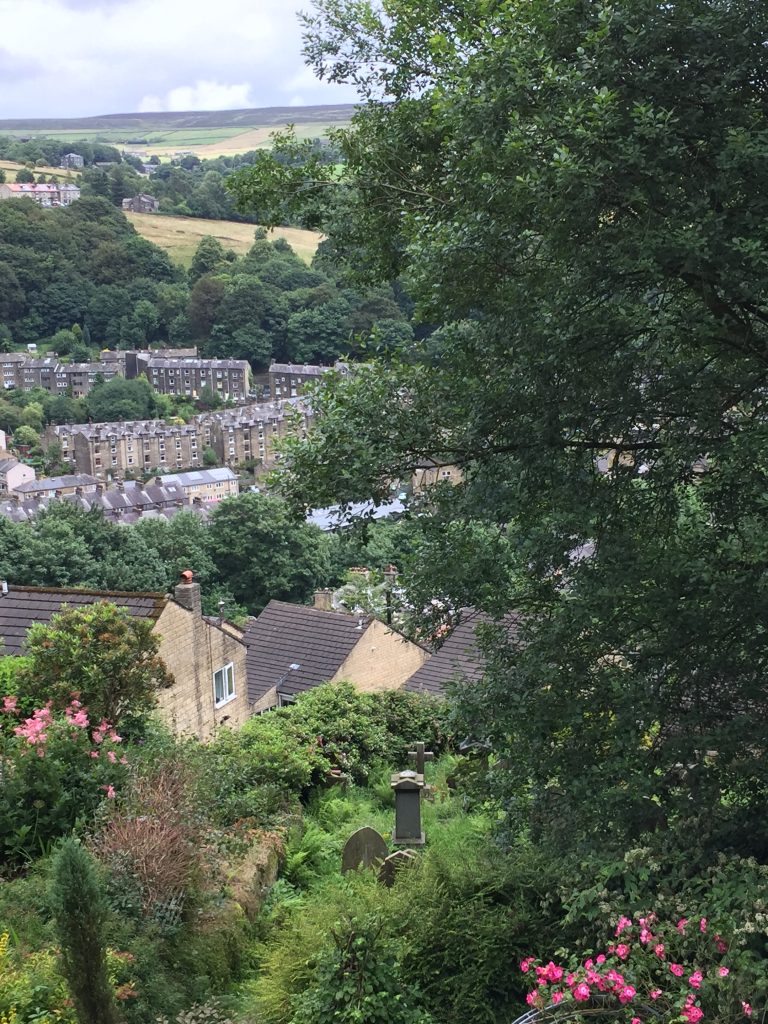

Cross Lanes cemetery 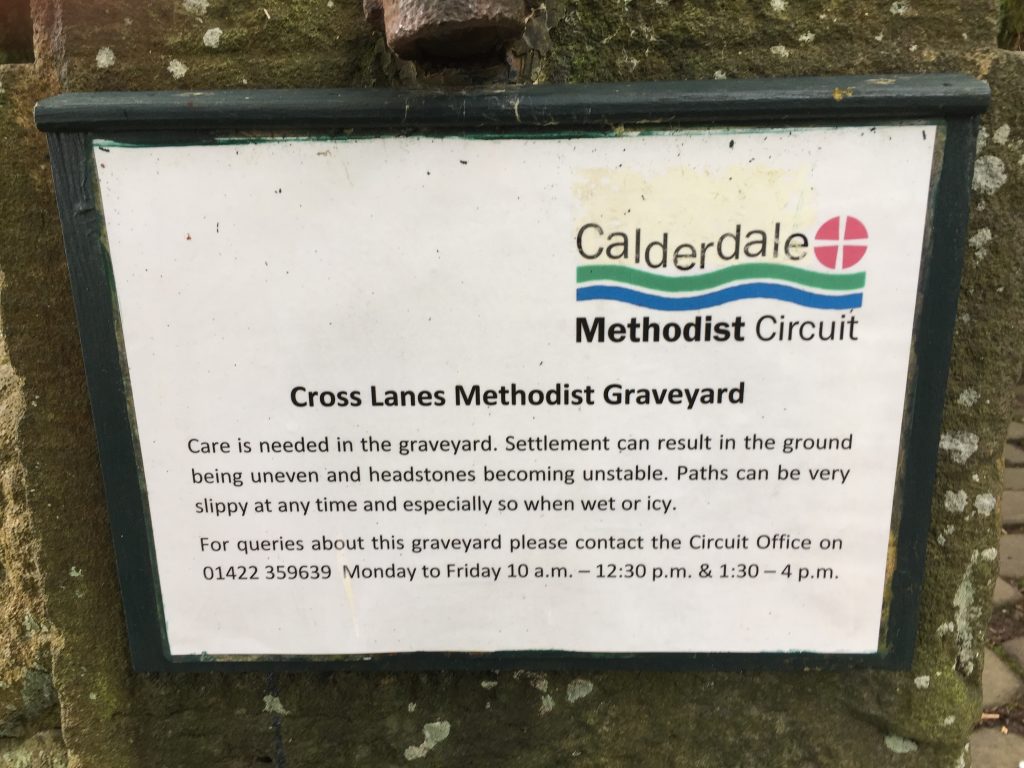
The couple settled in Nelson, Lancashire and three years after their wedding war broke out. As a medical man Walter’s expertise saw him involved in some of the fiercest fighting of that war. He offered his services to the war effort and in December 1915 he was granted a commission as lieutenant. According to the Todmorden Advertiser Six weeks after leaving Nelson he was at an advanced dressing station in France, and has been so engaged ever since except for a short period, when he was attached to one of the battalions of the Scottish Rifles. He was at one of the advanced dressing stations in the Somme operations. Wounded men would be sent to an Advanced Dressing Station after receiving an initial diagnosis at their front line Regimental Aid Post The ADS was normally run by a Field Ambulance, the name given to a mobile medical unit, not a vehicle. It was better equipped than the RAP, but could still only provide limited medical treatment. More serious cases would be referred to a Casualty Clearing Station, a larger and better-equipped facility that normally provided medical care for an entire division. In 1918 serving with the 93rd field ambulance in France Walter was promoted to Major and in July 1919 he was awarded the military cross, in recognition of his distinguished and meritorious service in battle situations. His father had died in 1912, and his mother in March 1919. What a pity they couldn’t have known about his military recognition. At the age of 48 Walter’s wife, Edith died and three years later he remarried. I am indebted to Jane Hall, the great great niece of Janet Junor Mackenzie, Walter’s second wife for the following information. Apparently Walter and Janet met on a cruise and were married at the Palace Hotel in Inverness on April 29, 1926. Janet was a lecturer in needlework, possibly at Aberdeen Teacher training College. Walter and Janet travelled a great deal throughout Europe before the second world war broke out and she kept a diary of their travels. Jane remembers visiting Walter & Janet at Stansfield Hall.
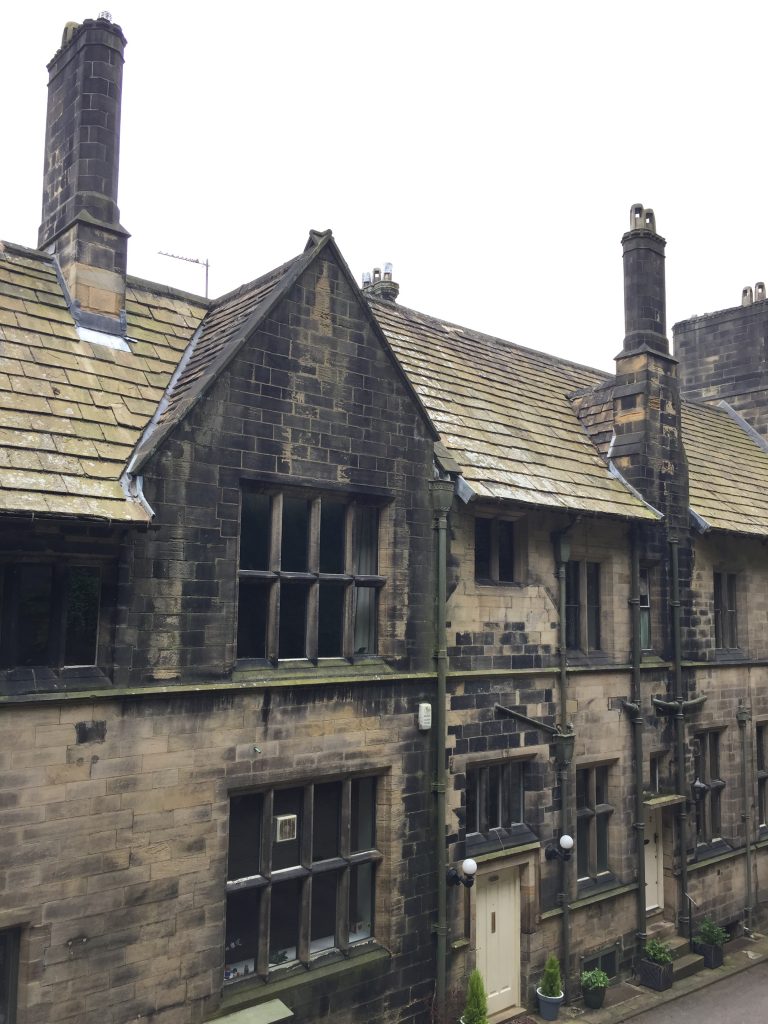
Stansfield Hall 
One part of the hall was Walter and Janet’s home 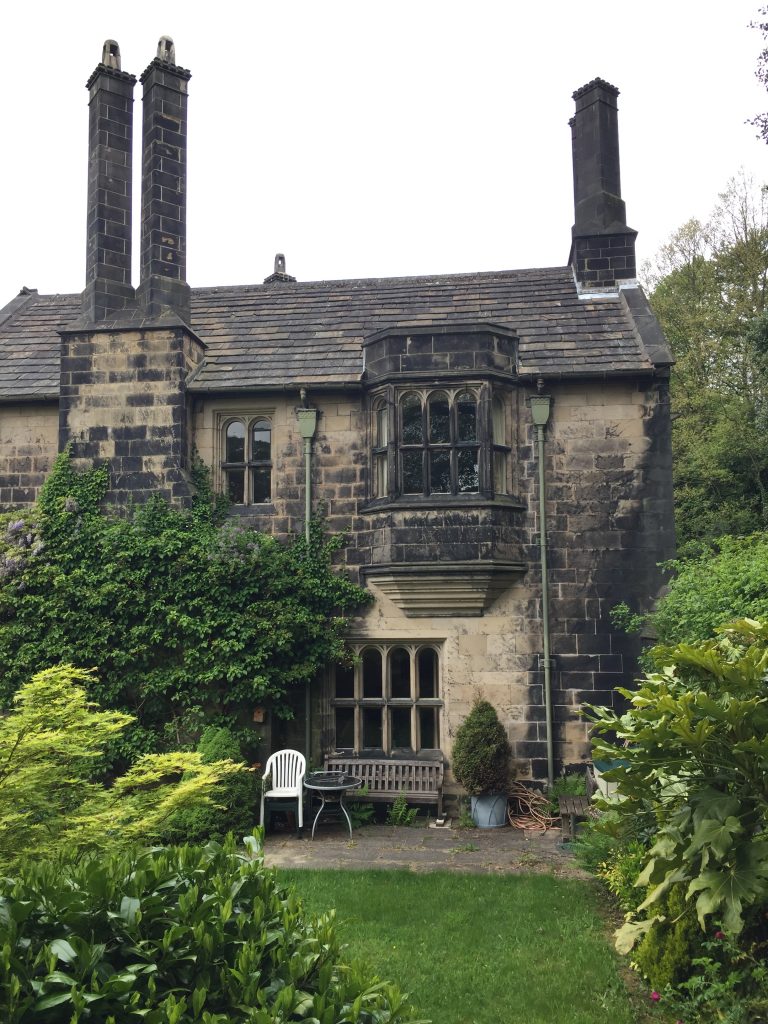
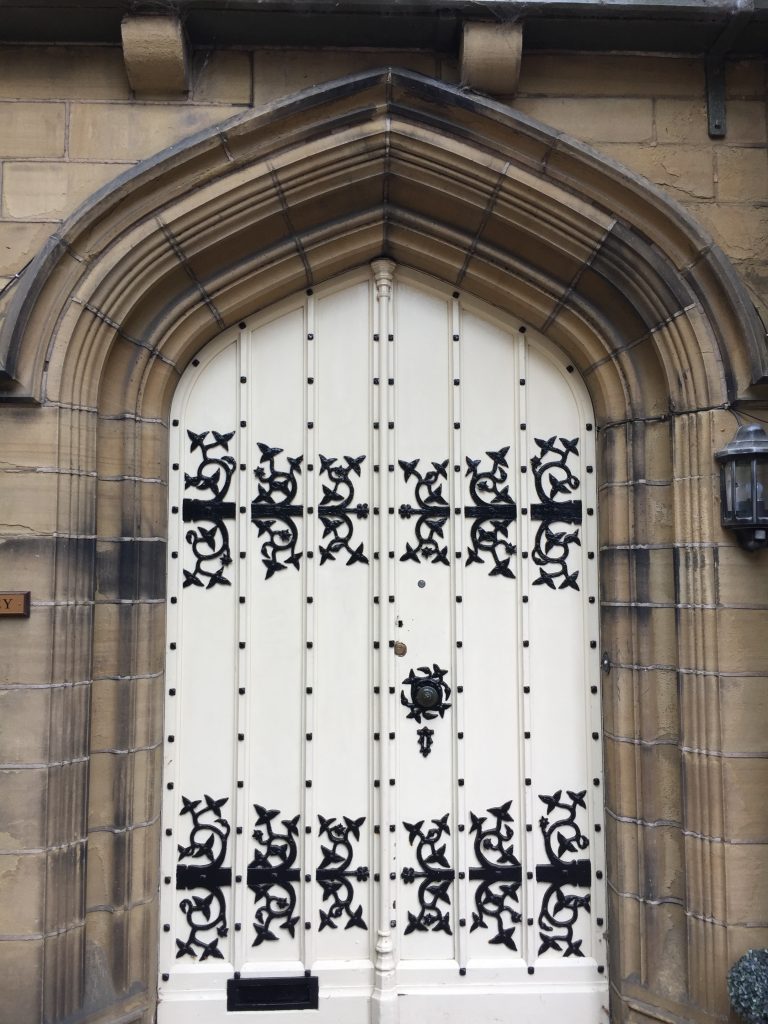
The main entrance
After Walter’s death in the summer of 1956 Janet moved back to the village of Avoch in the Black Isle Scotland, she moved into Rose Cottage the house where she was born, and she lived there until she died in 1968. Walter left 8000 pounds , close to 200,000 in today’s money.

For an account of my visit to Stansfield hall:
25th June 2022 at 10:32 pm
A very interesting story. I descend from Crabtrees of Love Clough, and before that, Hebden Bridge. I didn’t see any family connection, but there undoubtedly is one. A couple decades back, I exchanged emails with a researcher named Elizabeth Crabtree, by birth. I think her married name at the time was Crean, or something similar. My memory isn’t very good. She about as close of a blood relative as I have in England. In her younger years, she used to prowl cemeteries looking for info. It so happened that info that I had was just what she needed, and what she had was just what I had.
Thanks for an interesting story and interesting photos. I’ve been watching “Escape to the Country” and learning a lot about the landscape of Britain.
27th March 2024 at 10:21 pm
Hello –
I think Barker Crabtree, Charles’ son, was my Great Great Grandfather. I’m named I think after his son Abraham, my Great Grandfather. His son, my Grandfather Charles worked at the mill through the 30s with his father and they managed to keep it going through the depression (I think I remember my grandfather saying they were particularly good at spinning then.) My Grandfather ran the mill through the 50s and 60s successfully, but in spite of re-equipping it foundered in 1971.
My grandparents lived in the large, end house in Stansfield Hall that your pictures show. An absolutely amazing house that I visited many times in my childhood. They left in 1977 and then lived on the Mount, up the hill. I don’t know if my great grandparents lived in Stansfield Hall. I don’t think so, but I could be wrong. I don’t know how your relative was living there earlier in the century; I’ll ask my mother if she remembers anything.
Thank you for your excellent blog.
Best wishes …. Abraham Crabtree